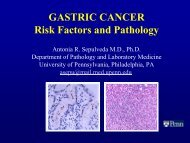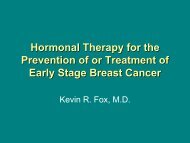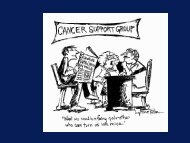Staging of NHL and CLL - Abramson Cancer Center
Staging of NHL and CLL - Abramson Cancer Center
Staging of NHL and CLL - Abramson Cancer Center
Create successful ePaper yourself
Turn your PDF publications into a flip-book with our unique Google optimized e-Paper software.
<strong>Staging</strong> <strong>of</strong> <strong>NHL</strong> <strong>and</strong> <strong>CLL</strong>Lisa Downs, CRNPCoordinator, Lymphoma Program<strong>Abramson</strong> <strong>Cancer</strong> <strong>Center</strong>Hospital <strong>of</strong> the University <strong>of</strong> Pennsylvania
<strong>Staging</strong>• Review <strong>of</strong> biopsy with ahematopathologist• Detailed history <strong>and</strong> physical• CT scan• Bone marrow biopsy• PET scan• Labs• ? laparotomy
Ann Arbor <strong>Staging</strong>• Stages I–IVIIV– Stage I• Single location– Stage II• 2 or more locations• Same side <strong>of</strong> diaphragm– Stage III• 2 or more locations• Both sides <strong>of</strong> diaphragm– Stage IV• Disseminated• Extranodal organ <strong>and</strong>/orspleen (E <strong>and</strong>/or S)• Systemic symptoms (A orB)Surveillance, Epidemiology, <strong>and</strong> End Results (SEER) Training website. Lymphoma staging scheme.http://training.seer.cancer.gov/module_staging_cancer/unit03_sec04_part07_lymphoma.html. Accessed May 21, 2007.
Early Stage Indolent <strong>NHL</strong>• A small percentage <strong>of</strong> patients arediagnosed with a low grade <strong>NHL</strong> asstage I or II• Vigorous staging is required– CT scan, PET scan– PCR testing if possible• 30-40% cure rate for those patientswith Stage I indolent <strong>NHL</strong> usingradiation• Weigh risks <strong>and</strong> benefits
Treatment Options: Low Grade <strong>NHL</strong>•Watch <strong>and</strong> wait•External beamradiation•ChemotherapySingle agentCombination•Monoclonal antibodyRituximabalemtuzumab•Interferon•Stem cell transplantAutologousAllogeneic• Radioimmunotherapy90Y Ibritumomab Tiuxetan131I Tositumomab•Investigational therapies
Watch <strong>and</strong> Wait• Indolent, low volume disease– Allows us to judge tempo <strong>of</strong> the disease– Treatment done in 2-525 years may bebetter or less toxic– It is rare, but spontaneous remissionsmay be as high as 10%– Does not affect the rate <strong>of</strong> transformation– It is not known that early treatmentaffects overall survival
The decision to treat• Collaborative decision between Pt. <strong>and</strong> MD• Enlarged lymph nodes that may sooncause a problem• Blood counts that have been affected• Paraneoplastic syndrome• Symptoms• Clinical trials• Discuss all options <strong>and</strong> risks <strong>and</strong> benefits
Factors Contributing todecision• Type <strong>of</strong> indolent <strong>NHL</strong>• Patient preference• Past therapies• Age <strong>of</strong> patient• Clinical trials available• Comorbid illnesses• Financial issues
9<strong>CLL</strong> <strong>Staging</strong>: Rai <strong>and</strong> BinetaImmune-mediated cytopenias are not the basis for these stage definitions.NCCN Clinical Practice Guidelines in Oncology. Non-Hodgkin’s Lymphomas. V.3.2008Binet . JL, et al. <strong>Cancer</strong>. 1981;48:198-206;Rai KR, et al. Blood. 1975;46:219-234.
10NCCN Diagnosis Guidelines• Essential:– Hematopathology review– Immunophenotyping to establish diagnosis– Cytogenetics or FISH* to detect del(17p), del(13q),+12, del(11q)• Useful under some circumstances:– Molecular genetic analysis to detect antigen receptorgene rearrangements– Determination <strong>of</strong> CD38 <strong>and</strong>/or Zap 70 expression byflow cytometry or immunochemistry* FISH for the t(11:14) chromosomal translocation can help distinguish MCL from <strong>CLL</strong>Adapted from NCCN Clinical Practice Guidelines in Oncology. Non-Hodgkin’s Lymphomas. V.3.2008.Kantarjian HM et al. MD Anderson Manual <strong>of</strong> Medical Oncology, 2006
11<strong>CLL</strong> Signs <strong>and</strong> Symptoms• Fever• Weight Loss• Loss <strong>of</strong> Appetite• Fatigue• Anemia• Leukopenia• Thrombocytopenia• Bone or Joint Pain• Lymph NodeEnlargement• Enlarged Liver• Enlarged Spleen• InfectionsEarly <strong>CLL</strong> may have no signs or symptoms.American <strong>Cancer</strong> Society. <strong>Cancer</strong> Facts & Figures 2008. Atlanta: American <strong>Cancer</strong> Society, 2008;NCCN Clinical Practice Guidelines in Oncology. Non-Hodgkin’s Lymphomas. V.3.2008.
Monitoring for <strong>CLL</strong>• Blood counts every 6-126weeks• Physical assessment every 6-126weeks– Assess liver <strong>and</strong> spleen size– Assess for enlarged lymph nodes• Assess for recurrent infections <strong>and</strong> organfunction• Assess for development <strong>of</strong> other cancers• Assess for changes in the disease
13<strong>CLL</strong> : Indications for Treatment• Active disease should be confirmed prior to initiating treatment• ≥1 1 <strong>of</strong> the following symptoms must be present:– Weight loss 10% within previous 6 months– Extreme fatigue– Fevers >100.5 o F for ≥2 2 weeks without evidence <strong>of</strong> infection– Night sweats without evidence <strong>of</strong> infection• Evidence <strong>of</strong> progressive marrow failure as manifest by thedevelopment or worsening <strong>of</strong> anemia <strong>and</strong>/or thrombocytopenia• Autoimmune anemia <strong>and</strong>/or thrombocytopenia poorlyresponsive to corticosteroid therapy• Massive spleen (i.e., >6cm below the left coastal margin) orprogressive splenomegaly• Massive nodes or clusters (i.e., 10 cm in longest diameter) orprogressivelymphadenopathy• Progressive lymphocytosis– >50% over a 2-month 2period– Lymphocyte doubling time <strong>of</strong>
NCCN Practice Guidelines for <strong>CLL</strong>Updated in 2008Use <strong>of</strong> specific drugs is reflective <strong>of</strong> NCCN guidelines, but not necessarily approved indications14SLL(localized)Locoregional RTPROGRESSION<strong>CLL</strong>/SLLSLLRai 0Rai I-IIRai III-IVdel (17p)




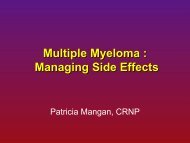

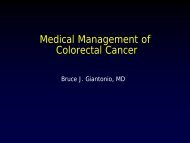
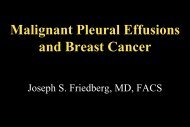
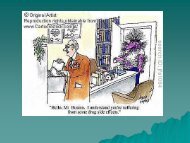
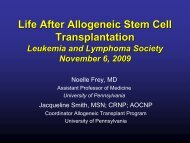
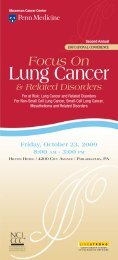
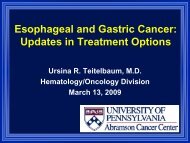
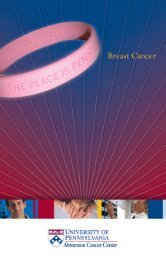
![Agenda [PDF] - Abramson Cancer Center](https://img.yumpu.com/35341208/1/190x245/agenda-pdf-abramson-cancer-center.jpg?quality=85)
